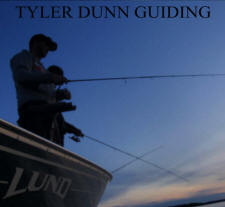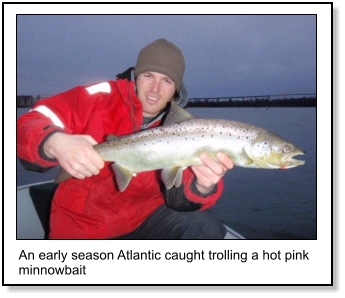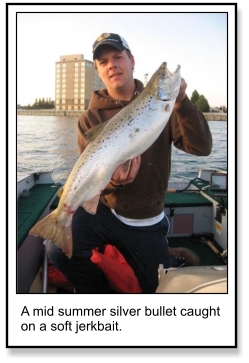|

|
 Northern
Ontario’s King of Chrome Northern
Ontario’s King of Chrome
By: Tyler Dunn
Tyler Dunn Guiding
The prized Atlantic salmon is most famous for
its population and sizes in the Eastern
provinces of Canada along the Atlantic Ocean.
Atlantic salmon were very plentiful in Ontario
at one time but previous over fishing completely
decimated the populations. Although Lake Ontario
does have an Atlantic stocking program, Northern
Ontario’s St. Mary’s River offers a thriving
population of aggressive, feeding Atlantic
salmon consistently each year. The entire
stocking program is funded, operated and
maintained by our American friends at Lake
Superior State University located in Sault Ste.
Marie, Michigan a twin city of the Canadian
side. The Aquatic Research Laboratory at LSSU
has stocked the river annually since 1987 with
more than 25 000 released in 2009 alone. These
fish can be found in the river year round
although prime time is from early June until the
Chinooks arrive in August. During these months,
anglers can witness Atlantics violently
attacking schools of smelts on the surface of
the water. It is definitely the closest thing I
have ever seen that most resembles a shark,
feeding frenzy in fresh water. The following is
a brief “how to” for targeting Atlantic salmon
in the St Mary’s River system.
 Many
methods can be used to target Atlantics but most
commonly fly, down rigging and spinning gear can
be used by fisherman from either shore or boat.
Since I don’t fly fish yet, during late spring I
usually always use down riggers and they produce
consistant results. I generally use either hard
minnow baits or spoons. Yo-suri crystal minnows,
jointed Rapalas and Storm ThunderSticks are all
effective lures I regularly use especially in
pink, orange and chartreuse during the early
portion of the season before the schools of
smelt show up into the river. My spoon offerings
in the spring begin with small Michigan Stingers
ranging in sizes from 2 ¼” to 3 ¾”. Any other
fluttering spoons such as Dream Weavers are also
great substitutes. The early season usually has
me fishing in the middle of the water column. If
I’m struggling to find fish I always send the
lures deeper towards bottom before they are
brought to the top portion of the water column.
As the season progresses, warming water
temperatures bring up massive schools of smelt
and other small baitfish to the top end of the
river. Many
methods can be used to target Atlantics but most
commonly fly, down rigging and spinning gear can
be used by fisherman from either shore or boat.
Since I don’t fly fish yet, during late spring I
usually always use down riggers and they produce
consistant results. I generally use either hard
minnow baits or spoons. Yo-suri crystal minnows,
jointed Rapalas and Storm ThunderSticks are all
effective lures I regularly use especially in
pink, orange and chartreuse during the early
portion of the season before the schools of
smelt show up into the river. My spoon offerings
in the spring begin with small Michigan Stingers
ranging in sizes from 2 ¼” to 3 ¾”. Any other
fluttering spoons such as Dream Weavers are also
great substitutes. The early season usually has
me fishing in the middle of the water column. If
I’m struggling to find fish I always send the
lures deeper towards bottom before they are
brought to the top portion of the water column.
As the season progresses, warming water
temperatures bring up massive schools of smelt
and other small baitfish to the top end of the
river.
Once this happens summer has usually begun and
the colour pattern changes from bright to white,
black/white or black/silver to best duplicate
their main forage. These fish have now begun to
gain some weight back from the long winter and
are showing characteristics of increasing energy
levels by becoming noticeably more aggressive.
As the season rolls into late June the peak
season has just begun and fly fisherman using
smelt pattern steamers definitely excel as do
spinning gear fisherman casting. This is when
the birds can be seen diving at the schools of
baitfish when the Atlantics push them to the
surface when attacking the school.
Spinning gear fisherman quickly cast directly at
the pods of feeding fish in hope of hooking one
of the visible feeding fish. Soft jerk baits,
Berkley Gulp and many other scented bass
plastics are incredibly exciting lures to hook
up with Atlantics on. Another option for the
soft baits besides looking for the pods of fish
on the surface is to drift areas of the fast
current breaks, cast and twitch them back to the
boat letting them drop anywhere from 2-10 feet
below the surface. Atlantics are just as
notorious as pike for follows, so don’t be
surprised to if receive
 15
follows or more a day using this technique. The
trolling gear still comes out on the water with
me even during the peak time because this
casting technique is generally used during first
light, last light or when the fish or heavily
feeding. I have caught them during the middle of
the day casting but trolling the same spoons as
above but bigger (4”-5”) and minnow baits only
2-5 feet below the surface either on a rigger or
even flat lined often is the ticket when fish
are spooky or seem dormant. The last part of the
season often becomes difficult as the fish move
into and around the base of the rapids to begin
the spawning season. Other species of fresh
Pacific salmon are now present and seem to push
Atlantics into hiding as they prepare for the
spawn. Up until 2010, the season was closed for
Atlantics at the end of September but has now
been opened all year long encouraging anglers to
target this species year round. 15
follows or more a day using this technique. The
trolling gear still comes out on the water with
me even during the peak time because this
casting technique is generally used during first
light, last light or when the fish or heavily
feeding. I have caught them during the middle of
the day casting but trolling the same spoons as
above but bigger (4”-5”) and minnow baits only
2-5 feet below the surface either on a rigger or
even flat lined often is the ticket when fish
are spooky or seem dormant. The last part of the
season often becomes difficult as the fish move
into and around the base of the rapids to begin
the spawning season. Other species of fresh
Pacific salmon are now present and seem to push
Atlantics into hiding as they prepare for the
spawn. Up until 2010, the season was closed for
Atlantics at the end of September but has now
been opened all year long encouraging anglers to
target this species year round.
Although the population has flourished and been
maintained for some time now, conservation of
the resource is still the most important aspect
in preserving this amazing fishery. A limit of
only 1 fish per angler is allowed and I do
suggest a meal of fresh Atlantic once in awhile.
It tastes great on a cedar plank but my
favourite is smoked!
|